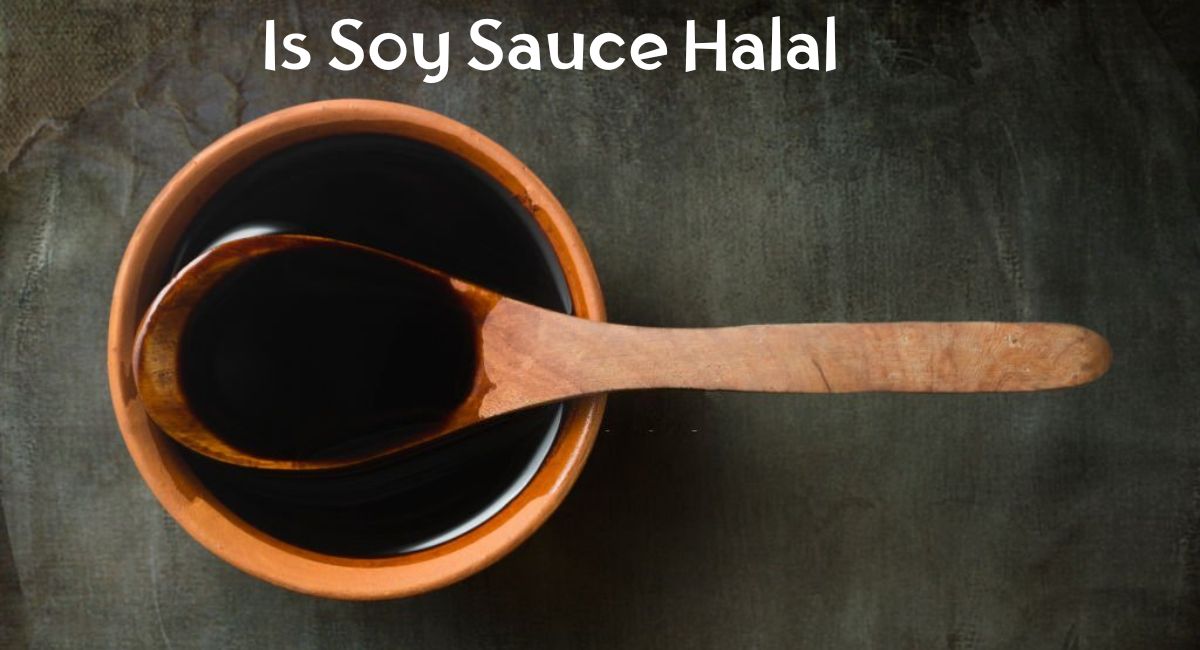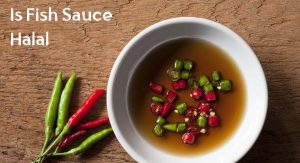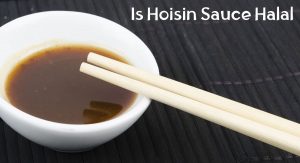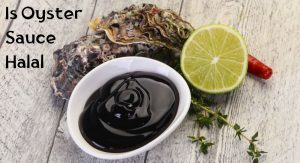Soy sauce is a beloved condiment that adds depth and umami flavor to a wide range of dishes, particularly in Asian cuisines. For Muslim individuals who adhere to halal dietary guidelines, the question of whether soy sauce is halal or permissible can arise. The halal status of soy sauce depends on various factors, including its ingredients and the manufacturing process.
While there may be different opinions among scholars, many consider soy sauce to be halal due to the fermentation process that transforms the soybeans and wheat used in its production. However, it is essential to check for any potential non-halal ingredients and alcohol content in specific brands or varieties.
In this article, we will explore the halal status of soy sauce, clarify common misconceptions, and provide insights for individuals seeking halal-certified soy sauce options.
Is Soy Sauce Halal
To determine whether soy sauce is halal or haram, it is important to analyse the ingredients and manufacturing process of soy sauce.
The basic ingredients of soy sauce are soybeans, wheat, salt, and fermenting agents like mold or yeast. All these ingredients are halal and permissible to consume.
To make soy sauce, the wheat is usually toasted, and the soybeans are boiled and mixed with the toasted wheat and salt to make a mash. The mash is then fermented for several months to several years, depending on the desired flavor and texture.
During fermentation, the mold or yeast breaks down the proteins and carbohydrates in the mash into amino acids, sugars, and organic acids. The resulting liquid is then pressed and filtered to remove solids and impurities. The final product is a salty, savory liquid with a rich umami flavor.
Some people have raised concerns about the fermentation process involved in making soy sauce.
According to Maulana Mustafa Umar, the process of fermentation does not make a product impermissible (haram) to consume. In the case of soy sauce, although it is produced through fermentation, it does not intoxicate and does not resemble wine in any significant way. Therefore, soy sauce is considered permissible (halal) to consume. This ruling is based on the perspective of the Hanafi school of thought.
Based on the above analysis, we can safely conclude that soy sauce as a product is halal.
However, to be fully considered halal the brand you buy must also be halal. Look for the halal sign or certification on the packaging. Alternatively, you can also scan through the ingredients to see whether the sauce contains alcohol or pork / pork by-products. The presence of pork in any form will make the product haram.
On the other hand, the presence of alcohol in food is complex topic in Islam. According to leading Hanafi scholars the incidental presence of alcohol in food items, such as soy sauce, is not considered haram as long as certain conditions are met. These conditions include:
- The alcohol is not being used to intoxicate.
- The amount of alcohol is not being used in a quantity that intoxicates.
- The alcohol is not being used as intoxicants are used.
- The alcohol is not being used for vain or useless purposes.
Mufti Faraz Adam also states that if the alcohol used in the production of soy sauce is obtained from sources other than grapes, dates, and raisins, and it is not present in a concentration that can cause intoxication, then the soy sauce would be considered permissible to use.
Is Kikkoman Soy Sauce Halal
Kikkoman Soy Sauce, with its rich heritage dating back to the 1600s, has become a beloved and essential ingredient in kitchens around the world. Renowned for its traditional brewing process and exceptional flavor, Kikkoman Soy Sauce offers a versatile and authentic taste that enhances a wide range of cuisines, from Asian dishes to mainstream American favorites.
The sauce is crafted using a centuries-old brewing process that begins with carefully selected soybeans, wheat, water, and salt. The ingredients undergo natural fermentation, allowing complex flavors to develop and resulting in a deep, rich umami taste.
Kikkoman currently offers the following soy sauce varieties:
- All-purpose Kikkoman Soy Sauce
- Kikkoman No Preservatives Added Gluten-Free Soy Sauce
- Organic Soy Sauce
- Smooth Aromatic Shoyu
- Double Fermented Shoyu
- Kikkoman Less Sodium Soy Sauce
- Kikkoman 50% Less Sodium Gluten-Free Tamari Soy Sauce
- Gluten-free Sweet Soy Sauce for Rice
- Sushi Sashimi Soy Sauce
- Soy Sauce With Lime
- Umami Joy Sauce
- Kikkoman Gluten-Free Tamari Soy Sauce
- 50% Less Sodium Gluten-free Tamari Soy Sauce (Non-GMO)
- Tamari Soy Sauce
So, is Kikkoman soy sauce halal? It is important to note that some Kikkoman soy sauces contain alcohol. The alcohol is a natural byproduct of the fermentation process and contributes to the flavor profile of the soy sauce. The exact alcohol content in Kikkoman soy sauces may vary, but it is generally less than 2% by volume and is unlikely to have any intoxicating effects. Therefore, as discussed earlier, there should be no issues in consuming Kikkoman soy sauce.
However, for those who want to err on the side of caution, Kikkoman does have some soy sauces that don’t contain alcohol. They are
- All-purpose Kikkoman Soy Sauce
- Kikkoman No Preservatives Added Gluten-Free Soy Sauce
- Organic Soy Sauce
- Kikkoman Less Sodium Soy Sauce
- Kikkoman 50% Less Sodium Gluten-Free Tamari Soy Sauce
- Gluten-Free Sweet Soy Sauce for Rice
- Sushi Sashimi Soy Sauce
- Soy Sauce With Lime
- Umami Joy Sauce
- Kikkoman Gluten-Free Tamari Soy Sauce
Halal Soy Sauce Alternatives
Here are some halal certified soy sauces that you can buy:
- “Waten” Sushi & Sashimi Sauce: This is a specific type of soy sauce that is Halal-certified and intended for use with sushi and sashimi. It has a slightly different flavor profile compared to regular soy sauce, being slightly sweeter and less prominent in taste to complement the fish.
- Hinode Halal Mirin-Style Seasoning: Mirin is a traditional sweet Japanese cooking rice wine widely used in Japanese recipes. Halal-certified mirin-style seasoning, produced by the brand Hinode, is available as an alternative for those looking for Halal Japanese ingredients. It adds an umami flavor to savory dishes like teriyaki chicken, ramen, and udon.
- Halal Powdered Soy Sauce: Salam Groovy Japan offers a powdered soy sauce that is Halal-certified. It is made from traditional soy sauce and can be used as a seasoning for various dishes, including sushi, sashimi, and tofu. The powdered form makes it portable and easy to use, with a shelf life of 5 years from production.
- Coconut Aminos: Coconut aminos is a liquid condiment similar to soy sauce but made from the fermented sap of a coconut palm tree and sea salt. It is a soy-free and gluten-free alternative to soy sauce that is rich in amino acids and has a slightly sweet and salty flavor. Coconut aminos can be used in place of soy sauce in a 1:1 ratio.
- Fish Sauce: Fish sauce is a liquid condiment made from fish or krill that have been coated in salt and fermented for up to two years. It is often made from anchovies, salt, and water, and is intensely flavored. Depending on its grade, fish sauce can be used as a dipping sauce, used to create marinades and condiments, or cooked into a meat or vegetable sauce.
- Mushroom Broth: Mushroom broth is a liquid base that can be used as a substitute for soy sauce in recipes that require a savory and umami flavor. It can be used in place of soy sauce in stir-fries, marinades, sauces, and dressings.
List of Halal Soy Sauces
According to halalharam.org, the following soy sauces are halal:
| Brand | Product Name | Status |
|---|---|---|
| White Rose | SOY SAUCE | Halal |
| Walmart | SOY SAUCE | Halal |
| Valu Time | SOY SAUCE | Halal |
| Super A | SOY SAUCE | Halal |
| Shurfine (Topco) | SOY SAUCE | Halal |
| Price Chopper | SOY SAUCE | Halal |
| Mrs. Adler’s | Lite Soy Sauce | Halal |
| Mrs. Adler’s | Soy Sauce | Halal |
| Key Food | SOY SAUCE | Halal |
| Jade Dragon | SOY SAUCE | Halal |
| Hy-Top | SOY SAUCE | Halal |
| Harvey’s | SOY SAUCE | Halal |
| Hannaford | SOY SAUCE | Halal |
| Great Value | SOY SAUCE | Halal |
| Gold Crest | Soy Sauce | Halal |
| Food Lion | SOY SAUCE | Halal |
| Food Club | SOY SAUCE | Halal |
| Crystal | Soy Sauce | Halal |
| Clear Value | SOY SAUCE | Halal |
| Borden | Soy Sauce | Halal |
| Allied Old English | Soy Sauce | Halal |
What is Soy Sauce
Soy sauce is a liquid condiment that originated in China and is widely used in East and Southeast Asian cuisines, as well as globally. It is known for its strong umami taste, which adds a savory flavor to dishes.
The history of soy sauce dates back approximately 2,200 years ago during the Western Han dynasty in ancient China. It was initially developed as a way to stretch salt, which was an expensive commodity at the time.
The early versions of soy sauce involved fermenting fish with salt and later evolved into using soybeans as the main ingredient, resulting in soy paste and soy sauce. Over time, the production techniques and ingredients were refined, leading to the soy sauce we know today.
Soy sauce gained popularity not only in China but also in other East and Southeast Asian countries. It became an essential ingredient in their cuisines and a common condiment worldwide. The flavor and characteristics of soy sauce can vary based on the region and the specific production methods used.
In addition to its use as a seasoning and flavor enhancer in cooking, soy sauce is often enjoyed as a dip or added to dishes like rice, noodles, sushi, and sashimi. It is commonly found on restaurant tables in many countries.
Types of Soy Sauce

Soy sauce comes in various types, each with its own characteristics and uses. Here are some common types of soy sauce:
- Light Soy Sauce: Also known as thin soy sauce, it is the most commonly used type in Chinese cooking. It has a thin consistency and a lighter color compared to other soy sauces. Light soy sauce adds a savory and salty flavor to dishes and is versatile in stir-fries, marinades, and dipping sauces.
- Dark Soy Sauce: Dark soy sauce has a thicker consistency and a dark brown color. It is aged for a longer period and has a more intense flavor. Dark soy sauce adds richness, sweetness, and a deep color to dishes. It is often used in braised meats, stews, and noodle dishes to enhance the flavor and appearance.
- Regular Soy Sauce: Regular soy sauce, also known as all-purpose soy sauce or koikuchi shoyu in Japanese, is the most common type worldwide. It has a balanced flavor and can be used in various dishes as a general seasoning. Regular soy sauce is dark brown and offers a combination of umami, salty, and slightly bitter flavors.
- Tamari: Tamari is a type of soy sauce that originated in Japan. It is made with little to no wheat, making it a suitable option for those with gluten sensitivity. Tamari has a rich, full-bodied flavor and is often used as a dipping sauce or added to soups and stir-fries.
- Shoyu: Shoyu is a Japanese soy sauce made from soybeans and wheat. It has a well-rounded flavor and is available in different varieties, such as light shoyu, dark shoyu, and premium shoyu. Shoyu is commonly used in Japanese cuisine, including sushi, sashimi, and noodle dishes.
- Sweet Soy Sauce (Kecap Manis): Sweet soy sauce, also known as kecap manis in Indonesian cuisine, is thick, syrupy, and sweet. It has a molasses-like flavor and is often used as a condiment or glaze in Indonesian and Malaysian dishes.
- Mushroom Soy Sauce: Mushroom soy sauce is infused with mushroom flavor, giving it a unique earthy taste. It is commonly used in Chinese and Southeast Asian cuisines to add depth to stir-fries, braised dishes, and noodle soups.
These are just a few examples of the types of soy sauce available. The flavor, color, and consistency may vary depending on the brand, region, and production process.
Ingredients Of Soy Sauce
The ingredients of soy sauce typically include:
- Soybeans: Soybeans are the main ingredient used to make soy sauce. They provide the base flavor and protein content.
- Wheat: Wheat is often added to the soybean mixture to enhance the fermentation process and add a slightly sweet flavor.
- Salt: Salt is an essential ingredient in soy sauce. It acts as a preservative and contributes to the salty taste.
- Water: Water is used to create the brine that is necessary for the fermentation process.
- Aspergillus oryzae or Aspergillus sojae molds: These molds are responsible for the fermentation of the soybean and wheat mixture. They help break down the proteins and carbohydrates into amino acids and sugars, which contribute to the flavor of soy sauce.
It’s important to note that different variations of soy sauce may have additional ingredients or variations in the proportions of these ingredients. Some commercial soy sauces may also contain hydrolyzed vegetable protein as a flavor enhancer. Additionally, variations in the production process can result in different flavors and aromas in soy sauce.
How is Soy Sauce Made
The process of making soy sauce involves fermentation and the interaction of microorganisms. Here’s a comprehensive explanation of how soy sauce is made:
- Koji Preparation: The first step in soy sauce production involves preparing koji, which is a key component of the fermentation process. Koji is made by steaming the soybeans and roasting the wheat. Afterward, a mold called Aspergillus oryzae or Aspergillus sojae is introduced to the mixture. This mold helps in breaking down the starches and proteins into simpler components.
- Fermentation: Once the koji is prepared, it is mixed with brine (saltwater solution) and transferred to fermentation vessels. The fermentation process occurs in two stages:
- Solid-State Fermentation (Koji Fermentation): The koji mixture is spread out in shallow trays or boxes and kept in a warm, humid environment. The mold present on the koji starts to convert the starches into sugars and proteins into amino acids. This process takes several days and is crucial for the development of flavors.
- Brine Fermentation (Moromi Fermentation): The koji is transferred to larger fermentation vessels and mixed with additional brine, soybeans, and sometimes other ingredients. This mixture is called moromi. During this stage, various microorganisms, including bacteria and yeast, interact to ferment the mixture further. The fermentation can last for several months to years, depending on the desired flavor and type of soy sauce being produced.
- Solid-State Fermentation (Koji Fermentation): The koji mixture is spread out in shallow trays or boxes and kept in a warm, humid environment. The mold present on the koji starts to convert the starches into sugars and proteins into amino acids. This process takes several days and is crucial for the development of flavors.
- Pressing and Filtration: After the fermentation period, the moromi mixture is pressed to separate the liquid soy sauce from the solid residue. Traditional methods involve using wooden or cloth presses to extract the liquid. The extracted liquid is then filtered to remove any remaining solid particles and sediments.
- Pasteurization and Aging: The filtered soy sauce undergoes pasteurization to kill any remaining microorganisms and ensure its stability. It is then aged in tanks or barrels to further develop its flavor and aroma. The aging period can vary depending on the desired characteristics of the soy sauce.
- Bottling and Packaging: Once the aging process is complete, the soy sauce is ready for bottling and packaging. It is typically bottled in glass or plastic containers, labeled, and sealed for distribution and sale.
How to Use Soy Sauce

Using soy sauce in cooking can add a savory and umami flavor to a variety of dishes. Here are some common ways to use soy sauce:
- As a condiment: Soy sauce can be used as a condiment by adding it directly to rice-based dishes, such as fried rice, to enhance the flavor. Start by adding 1 tablespoon (15 mL) to your food and adjust according to your taste preference.
- In cooking: Soy sauce can be used as an ingredient in various recipes to add depth and richness. It can be used as a marinade for meats, poultry, or tofu to infuse flavor before cooking. It can also be added to stir-fry sauces, soups, and noodle dishes for seasoning.
- Dipping sauce: Soy sauce can be combined with other ingredients like rice vinegar, sesame oil, or chili sauce to create a delicious dipping sauce for dumplings, spring rolls, or other appetizers.
- Salad dressing: Soy sauce can be incorporated into salad dressings, typically combined with ingredients like rice vinegar, sesame oil, honey, or ginger, to add a savory element to the dressing.
- Basting or glazing: Soy sauce can be used as a basting sauce or glaze for meats or poultry before grilling or roasting. It adds flavor and helps create a caramelized or glossy coating.
- Seasoning vegetables: Steamed or grilled vegetables can be enhanced by drizzling soy sauce over them before serving. The soy sauce adds a savory note and complements the natural flavors of the vegetables.
- Sweet dishes: While soy sauce is commonly associated with savory dishes, it can also be used in sweet recipes. For example, soy sauce can be added to chocolate cake frosting or used in marinades for sweet and savory dishes like caramelized parsnips.
- As a substitute: If a recipe calls for a specific type of soy sauce but you don’t have it on hand, you can generally substitute light soy sauce or all-purpose soy sauce. However, it’s important to note that dark soy sauce has a stronger and more intense flavor and should only be used when specified in a recipe.
When using soy sauce, it’s important to be mindful of its salt content and avoid using excessive amounts, as it can overpower the flavors of the dish. Additionally, if you have specific dietary requirements or preferences, such as seeking gluten-free or Halal-certified soy sauce, make sure to choose the appropriate product based on your needs.
Why Do People Avoid Soy Sauce
Soy sauce is a flavorful ingredient made from fermented soybeans and wheat. However, some people avoid soy sauce for various reasons, including:
- Allergies or Sensitivities: Some individuals have soy allergies or sensitivities, which can cause adverse reactions when consuming soy products, including soy sauce. Common symptoms of a soy allergy include tingling, hives, swelling, wheezing, and digestive issues.
- Gluten Intolerance or Celiac Disease: Traditional soy sauce is typically brewed with wheat, which contains gluten. This makes soy sauce unsuitable for individuals with gluten intolerance or celiac disease. However, gluten-free soy sauce alternatives like tamari are available.
- Sodium or Dietary Restrictions: Soy sauce is high in sodium, and individuals with high blood pressure or those following a low-sodium diet may choose to limit their consumption of soy sauce.
- Personal Dietary Choices: Some people may avoid soy sauce for personal or cultural reasons, or they may prefer alternative condiments and seasonings to suit their taste preferences or dietary choices.
- Avoiding Soy Products: People following a soy-free diet, whether due to allergies, sensitivities, or personal choices, will avoid soy sauce as it is made from fermented soybeans. Soy can be found in various foods, including processed foods, dairy substitutes, breaded foods, and cereals.
- Health concerns: Soy sauce contains high levels of sodium and other chemicals that can lead to conditions like heart disease. Additionally, soy sauce can obstruct protein digestion and mineral absorption, and it can lower sperm count and affect neurological health. However, these claims have not been substantiated, and soy is still considered a nutrient-dense source of protein that can provide health benefits when consumed in moderation.
- Production methods: Soy sauces that have not been naturally fermented might be bad for you because they could contain a toxic substance called 3-MCPD. Non-brewed soy sauce is made within days and is often merely a combination of hydrolyzed soy protein and unhealthy flavorings such as corn syrup and caramel.
Despite these concerns, soy sauce can still be enjoyed as part of a healthy diet, especially if you opt for gluten-free soy sauce and consume it in moderation.
Looking for the halal status of other sauces that have a salty, umami flavour profile similar to soy sauce? Take a look at these article
Is Fish Sauce Halal: Delve into the savory depths of fish sauce and its Halal status. This article provides a comprehensive examination of fish sauce, shedding light on whether it is permissible in Islamic dietary practices.
Is Oyster Sauce Halal: Uncover the secrets behind the umami-rich oyster sauce and its compatibility with Halal dietary restrictions. This article delves into the ingredients and processes to determine its Halal status.
Is Worcestershire Sauce Halal: Explore the tangy and flavorful world of Worcestershire sauce, and get clarity on whether it meets the criteria for Halal consumption. This article breaks down the components to help you make an informed decision.
Is Hoisin Sauce Halal: Satisfy your curiosity about the delectable Hoisin sauce and its place in Halal cuisine. This article provides insight into the ingredients and production methods to determine its Halal or Haram classification.
Frequently Asked Questions
1. Does soy sauce have alcohol?
Traditional soy sauce is brewed through a fermentation process that involves the use of yeast and mold. During fermentation, alcohol is produced as a byproduct. However, the final soy sauce product typically has very low alcohol content, usually less than 0.5%. Therefore, soy sauce is generally considered to be alcohol-free.
2. Is naturally brewed soy sauce halal?
The halal status of soy sauce depends on its production process and ingredients. Naturally brewed soy sauce can be halal if it is made from halal ingredients and there are no non-halal additives involved. To be sure about the halal status of a specific soy sauce brand, it is recommended to check for halal certification or consult with a reliable halal certification authority.
3. Is alcohol in soy sauce halal?
The presence of alcohol in food and beverages is a matter of concern for some individuals following Islamic dietary guidelines. The halal status of soy sauce containing alcohol can vary depending on the amount of alcohol present. Some Islamic scholars consider soy sauce with very low alcohol content (less than 0.5%) to be permissible (halal) for consumption, while others may have different interpretations. It is advisable to refer to specific halal certification guidelines or consult with a reliable halal certification authority for a definitive answer.
4. Is soy sauce really good for you?
Soy sauce is a condiment that adds flavor to dishes, but its nutritional value can vary. It is a source of sodium and can contribute to the overall sodium intake in your diet. While soy sauce contains some beneficial compounds, such as antioxidants and certain amino acids, it is typically consumed in small amounts, so its overall impact on health is limited. As with any food, moderation is key. If you have specific dietary concerns or health conditions, it is advisable to consult with a healthcare professional or registered dietitian.
5. What is the main purpose of soy sauce?
The main purpose of soy sauce is to enhance the flavor of various dishes. It is commonly used as a seasoning and condiment in Asian cuisine. Soy sauce adds a savory, umami taste to stir-fries, marinades, sauces, and dressings. It can also be used as a dipping sauce for sushi, sashimi, dumplings, and other foods.
6. Is there MSG in soy sauce?
Traditional soy sauce is naturally rich in glutamic acid, which is an amino acid responsible for the umami taste. Glutamic acid can occur naturally in soy sauce without the addition of monosodium glutamate (MSG). However, some commercially produced soy sauces may contain added MSG or other flavor enhancers. It is recommended to check the ingredient list or consult the manufacturer to determine if a specific soy sauce product contains MSG.








